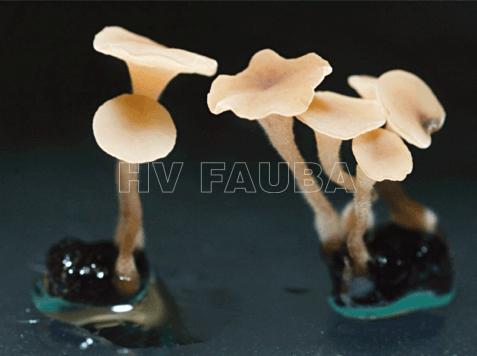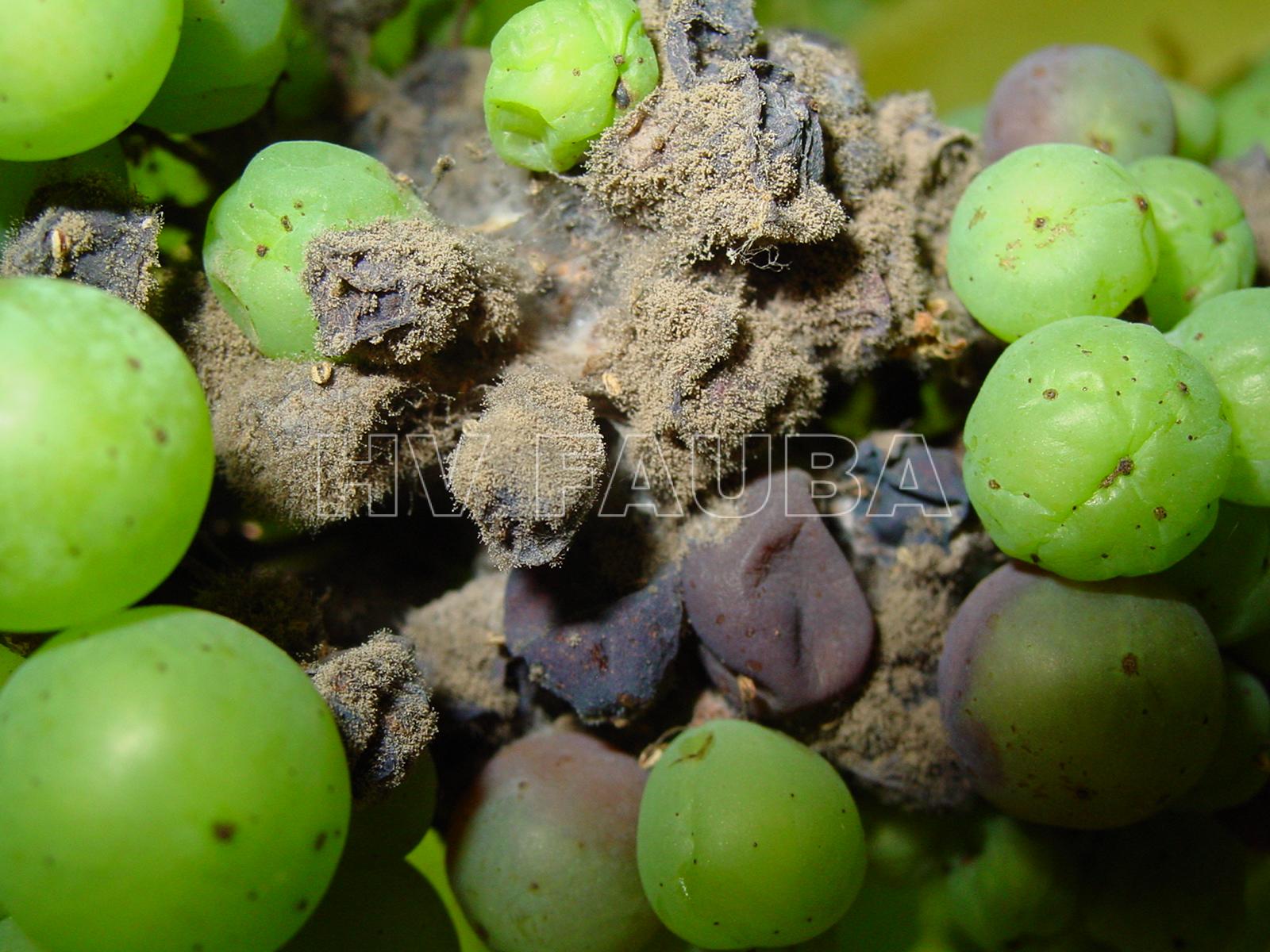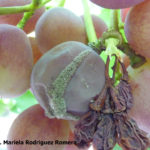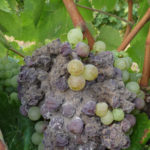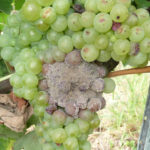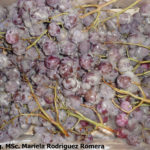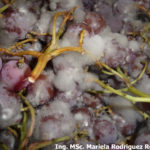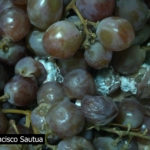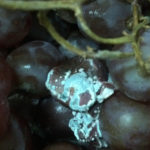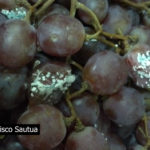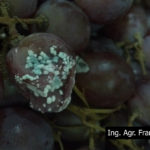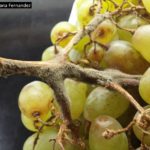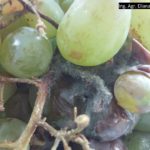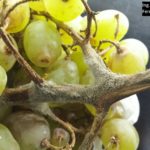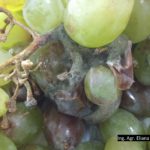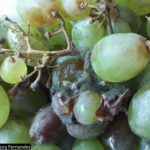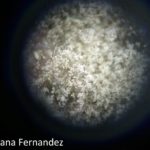.
Condición fitosanitaria: Presente
Grupo de cultivos: Frutícolas
Especie hospedante: Vid (Vitis vinifera)
Rango de hospedantes: no específico / amplio. B. cinerea es un hongo polífago con un amplio rango de hospedantes y de amplia difusión mundial, siendo el agente causal de la podredumbre gris en diversos cultivos de importancia económica, tales como el arándano, la vid, el kiwi, la frutilla, el tomate, etc. Se han reportado más de 1400 especies de plantas atacadas por Botrytis, de 596 géneros, en 170 familias (Fillinger & Elad, 2016).
Epidemiología: policíclica, subaguda
Etiología: Hongo. Necrotrófico
Agente causal: Botrytis cinerea Pers.:Fr. (anamorfo), Botryotinia fuckeliana (de Bary) Whetzel (teleomorfo)
Taxonomía: Eukaryota > Fungi > Dikarya > Ascomycota > Pezizomycotina > Leotiomycetes > Helotiales > Sclerotiniaceae > Botrytis
.
- Cuerpos de fructificación sexual (apotecio), a partir de estructura de resistencia (esclerocio), del teleomorfo Botryotinia fuckeliana. Autor: Dean et al., 2012.
.
.
Sintomatología
La podredumbre gris puede afectar a todos los órganos verdes de la vid, pero principalmente a los racimos, ocasionando diferentes síntomas y daños según el órgano atacado. En hojas, los síntomas se manifiestan, frecuentemente, en el borde del limbo en forma de amplias necrosis que tienen el aspecto de quemaduras. Si hay condiciones de húmedad suficientes, aparece sobre el borde de las manchas un polvillo gris (esporulación). Los ataques en hojas no suelen tener importancia económica.
En brotes jóvenes y sarmientos, los primeros síntomas se manifiestan por la presencia de manchas alargadas de color chocolate, que se recubren de una pelusilla grisácea si el tiempo es húmedo. Los ataques fuertes pueden ocasionar la pérdida de algunos brotes jóvenes, con la consiguiente disminución de cosecha y, posteriormente, la de algunas yemas de la base de los sarmientos, que no brotan al año siguiente.
En racimos, los síntomas durante el periodo floración-cuajado se manifiestan sobre las inflorescencias y en el raspón del racimo en forma de manchas color chocolate. Durante el periodo envero-recolección, las uvas presentan un aspecto característico de “podridos” y sobre su superficie se desarrolla un moho de color
grisáceo típico. Los ataques en ambos periodos pueden ocasionar una disminución importante de cosecha. Además, en el periodo envero-recolección ocasionan una disminución de calidad en los futuros vinos debido a la degradación de las materias colorantes, la destrucción de la película que contiene las sustancias aromáticas,
la reducción del grado alcohólico, el aumento de fijación de SO2 en los vinos y el aumento de la acidez volátil. Los
síntomas en racimo, durante el periodo de floración-cuajado, pueden confundirse con los ocasionados por el mildíu, pero éste deseca el raspón que se encorva en forma de S y se recubre de una pelusilla blanquecina.
.
- Eflorescencia gris (compuesta de la esporulación, conidios en conidióforos libres, de Botrytis cinerea. Autor: Government of Western Australia
.
Daños
La enfermedad disminuye el rendimiento y la calidad de la uva. Los daños más significativos que se producen a partir del envero (cuando las uvas dejan de ser verdes y empiezan adquirir color), se manifiestan mediante un polvillo grisáceo en los granos de uva y que al final toman un aspecto de podridos. En uvas de vinificar al producir cambios en la En uvas de vinificar, al producir cambios en la composición química de las bayas y producción de enzimas que dificultan la clarificación del vino.
.
- 01 Esporulación (signo) de Botrytis cinerea en uva, Mendoza. Autor: Ing. MSc. Mariela Rodriguez Romera.
- 02 Esporulación (signo) de Botrytis cinerea en racimos de uva a campo, Mendoza. Autor: Ing. MSc. Mariela Rodriguez Romera.
- 03 Esporulación (signo) de Botrytis cinerea en racimos de uva a campo, Mendoza. Autor: Ing. MSc. Mariela Rodriguez Romera.
- 04 Esporulación (signo) de Botrytis cinerea en racimos de uva en poscosecha (empaque=, Mendoza. Autor: Ing. MSc. Mariela Rodriguez Romera.
- 05 Esporulación (signo) de Botrytis cinerea en racimos de uva en poscosecha (empaque=, Mendoza. Autor: Ing. MSc. Mariela Rodriguez Romera.
- 01 Botrytis cinerea en Vid
- 02 Botrytis cinerea en Vid
- 03 Botrytis cinerea en Vid
- 04 Botrytis cinerea en Vid
- 05 Botrytis cinerea en vid
- 06 Botrytis cinerea en vid
- 07 Botrytis cinerea en vid
- 08 Botrytis cinerea en vid
- 09 Botrytis cinerea en vid
- 10 Conidios y conidióforos de Botrytis cinerea en vid
.
Ciclo de vida del patógeno
Botrytis cinerea sobrevive en dos formas distintas. El micelio del hongo vivo puede sobrevivir en el tejido de la planta (caña). Por otra parte, las estructuras de resistencia (de 3 a 6 mm de longitud, duras y negras) conocidas como esclerocios pueden sobrevivir en reposo adheridas a la vid o en materia en descomposición en la hojarasca del suelo. El hongo también puede sobrevivir infectando otros hospedantes dentro y alrededor del viñedo.
En condiciones de alta humedad relativa y con un mínimo de mojado foliar o de superficies vegetales (variable según la temperatura), ambas formas del hongo producen esporas. Estas pueden propagarse por el viento o por salpicaduras de agua y germinar en el tejido verde. Las flores son una fuente natural de tejido dañado. Un sitio común de infección ocurre cuando el casquete floral se ha desprendido y ha dejado una herida.
La infección de las bayas verdes puede no ser visible hasta que las bayas se ablanden y el clima húmedo proporcione las condiciones propicias para el desarrollo de la enfermedad. La infección puede propagarse a las bayas adyacentes o pueden iniciarse nuevas infecciones a partir de esporas transportadas por el aire que se depositan en el tejido susceptible. El desarrollo tardío de los síntomas después de una infección inicial a principios de la temporada se conoce como infección latente. Incluso cuando las bayas están infectadas, es posible que no se produzca podredumbre si las condiciones ambientales no favorecen el desarrollo de la enfermedad.
.
- Ciclo de vida del patógeno Botrytis cinerea en el cultivo de vid. Autores: Magarey PA, Nicholas P, Wachtel M, 1994
.
.
Epidemiología
En general el moho gris (Botryotinia fuckeliana / Botrytis cinerea) se considera un patógeno débil, que solo infecta las plantas dañadas o débiles. Las condiciones predisponentes a la enfermedad son las temperaturas en torno a 18ºC, humedad relativa superior al 90%, y agua libre. Cuando se originan lluvias durante la floración-cuajado, el hongo puede provocar la desecación parcial o total del racimo. Los conidias se dispersan con el viento y el agua.
.
.
Manejo
* Aplicación de fungicidas sistémicos. En la fenología del cultivo se consideran 4 momentos críticos para el control de la enfermedad:
– fin de floración
– inicio de cuajado
– cierre de racimo
– inicio de envero y
– 21 días antes de la vendimia
* Evitar el exceso de vigor de los viñedos, eligiendo un patrón, en el momento de la plantación, adaptado a la zona y a su régimen pluviométrico, y que, considerando el vigor de la variedad elegida, garantice un desarrollo de las cepas lo más equilibrado posible.
* Los despuntes, así como los deshojados realizados tras la floración y cuajado, favorecen la aireación de los racimos, disminuyen el riesgo de contaminación del hongo y favorecen la acción de los fungicidas aplicados.
* No excederse en fertilización nitrogenada.
* Se recomienda evitar la proximidad a la plantación de restos vegetales y la acumulación durante las fases finales del cultivo de racimos infectados sobre el suelo.
.
Bibliografía
Botrytis cinerea. Sistema Nacional Argentino de Vigilancia y Monitoreo de plagas
Amselem J, Cuomo CA, van Kan JAL, et al. (2011) Genomic Analysis of the Necrotrophic Fungal Pathogens Sclerotinia sclerotiorum and Botrytis cinerea. PLoS Genet 7(8): e1002230. doi: 10.1371/journal.pgen.1002230
Bi K, Scalschi L, Jaiswal N, et al. (2021) The Botrytis cinerea Crh1 transglycosylase is a cytoplasmic effector triggering plant cell death and defense response. Nature Communications 12: 2166. doi: 10.1038/s41467-021-22436-1
Bleyer K, Bleyer G, Schumacher S (2023) Using ontogenetic resistance of grapevine for fungicide reduction strategies. Eur J Plant Pathol 165: 115–124. doi: 10.1007/s10658-022-02592-w
Cai Q, Qiao L, Wang M, et al. (2018) Plants send small RNAs in extracellular vesicles to fungal pathogen to silence virulence genes. Science 17 May 2018: eaar4142. DOI: 10.1126/science.aar4142
Cheung N, Tian L, Liu X, Li X (2020) The Destructive Fungal Pathogen Botrytis cinerea—Insights from Genes Studied with Mutant Analysis. Pathogens 9(11): 923. doi: 10.3390/pathogens9110923
Dean R, Van Kan JAL, Pretorius ZA, et al. (2012) The Top 10 fungal pathogens in molecular plant pathology. Molecular Plant Pathology 13: 414–430. doi: 10.1111/j.1364-3703.2011.00783.x
Duan Y, Yang Y, Wang JX, et al. (2018) Simultaneous detection of multiple benzimidazole resistant β-tubulin variants of Botrytis cinerea using loop mediated isothermal amplification. Plant Disease (accepted). doi: 10.1094/PDIS-03-18-0542-RE
Emmanuel CJ, van Kan JA, Shaw MW (2018) Differences in the gene transcription state of Botrytis cinerea between necrotic and symptomless infections of lettuce and Arabidopsis thaliana. Plant Pathology doi: 10.1111/ppa.12907
Feng X (2017) Characterization of fungicide resistance in grape powdery and downy mildew using field trials, bioassays, genomic, and transcriptomic approaches: quinoxyfen, phosphite, and mandipropamid. Ph D Thesis, Virginia Polytechnic Institute and State University. Link
Fillinger S, Elad Y (2016) Botrytis – the Fungus, the Pathogen and its Management in Agricultural Systems. Springer International Publishing Switzerland. doi: 10.1007/978-3-319-23371-0
Frías M, González C, Brito N (2011) BcSpl1, a cerato-platanin family protein, contributes to Botrytis cinerea virulence and elicits the hypersensitive response in the host. New Phytologist 192: 483–495. doi: 10.1111/j.1469-8137.2011.03802.x
Garfinkel AR (2021) The History of Botrytis Taxonomy, the Rise of Phylogenetics, and Implications for Species Recognition. Phytopathology 111(3): 437-454. doi: 10.1094/PHYTO-06-20-0211-IA
Gebremichael DE, Ciofini A, Sabbadini S, et al. (2025) Exogenous dsRNAs against chitin synthase and glucan synthase genes suppress the virulence of the pathogenic fungus Botrytis cinerea. J Plant Pathol 107: 251–264. doi: 10.1007/s42161-024-01812-y
Gupta R, Anand G, Pizarro L, et al. (2021) Cytokinin Inhibits Fungal Development and Virulence by Targeting the Cytoskeleton and Cellular Trafficking. ASM Journals mBio 12. doi: 10.1128/mBio.03068-20
Hahn M (2014) The rising threat of fungicide resistance in plant pathogenic fungi: Botrytis as a case study. Journal of Chemical Biology 7: 133–141. doi: 10.1007/s12154-014-0113-1
Hahn M, Viaud M, van Kan J (2014) The Genome of Botrytis cinerea, a Ubiquitous Broad Host Range Necrotroph. In: R. A. Dean et al. (eds.), Genomics of Plant-Associated Fungi and Oomycetes: Dicot Pathogens, Springer-Verlag Berlin Heidelberg 2014. doi: 10.1007/978-3-662-44056-8_2
Harper LA, Paton S, Hall B, et al. (2022) Fungicide resistance characterized across seven modes of action in Botrytis cinerea isolated from Australian vineyards. Pest Manag Sci. 78: 1326-1340. doi: 10.1002/ps.6749
Hatmi S, Villaume S, Trotel-Aziz P, et al. (2018) Osmotic Stress and ABA Affect Immune Response and Susceptibility of Grapevine Berries to Gray Mold by Priming Polyamine Accumulation. Frontiers in Plant Science 9:1010. doi: 10.3389/fpls.2018.01010
Hu MJ, Cox KD, Schnabel G (2016) Resistance to Increasing Chemical Classes of Fungicides by Virtue of “Selection by Association” in Botrytis cinerea. Phytopathology 106(12): 1513-1520. doi: 10.1094/PHYTO-04-16-0161-R
Izquierdo-Bueno I, González-Rodríguez VE, Simon A, et al. (2018) Biosynthesis of abscisic acid in fungi: identification of a sesquiterpene cyclase as the key enzyme in Botrytis cinerea. Environ Microbiol. 20(7): 2469-2482. doi: 10.1111/1462-2920.14258
Jiang M, Xu X, Song J, et al. (2021) Streptomyces botrytidirepellens sp. nov., a novel actinomycete with antifungal activity against Botrytis cinerea. Int J Syst Evol Microbiol. 71(9). doi:
Kirschbaum DS, Alderete GL, Rivadeneira M, et al. (2015) Reconocimiento de plagas, organismos benéficos y enfermedades habituales del cultivo de frutillas en en noroeste argentino. Guía práctica de campo. Editor/es: Min. de Producción, SAF, Delegación Jujuy. INTA. PRODERI.. – Página/s: 20.
Kretschmer M, Leroch M, Mosbach A, et al. (2009) Fungicide-Driven Evolution and Molecular Basis of Multidrug Resistance in Field Populations of the Grey Mould Fungus Botrytis cinerea. PLoS Pathog 5(12): e1000696. doi: 10.1371/journal.ppat.1000696
Kumari S, Tayal P, Sharma E, Kapoor R (2014) Analyses of genetic and pathogenic variability among Botrytis cinerea isolates. Microbiological Research 169: 862-872. doi: 10.1016/j.micres.2014.02.012
Kuroyanagi T, Bulasag AS, Fukushima K, et al. (2022) Botrytis cinerea identifies host plants via the recognition of antifungal capsidiol to induce expression of a specific detoxification gene. PNAS Nexus 1(5): pgac274. doi: 10.1093/pnasnexus/pgac274
Leisen T, Werner J, Pattar P, et al. (2022) Multiple knockout mutants reveal a high redundancy of phytotoxic compounds contributing to necrotrophic pathogenesis of Botrytis cinerea. PLoS Pathog 18(3): e1010367. doi: 10.1371/journal.ppat.1010367
Li X, Gao X, Hu S, et al. (2022) Resistance to pydiflumetofen in Botrytis cinerea: risk assessment and detection of point mutations in sdh genes that confer resistance. Pest Manag Sci 78: 1448-1456. doi: 10.1002/ps.6762
Li X, Yang J, Jiang Q, et al. (2022) Baseline sensitivity and control efficacy of a new QiI fungicide, florylpicoxamid, against Botrytis cinerea. Pest Manag Sci. 78: 5184-5190. doi: 10.1002/ps.7137
Liu Y, Liu JK, Li GH, et al. (2019) A novel Botrytis cinerea-specific gene BcHBF1 enhances virulence of the grey mould fungus via promoting host penetration and invasive hyphal development. Molecular Plant Pathology 20(5): 731-747. doi: 10.1111/mpp.12788
Liu K, Wen Z, Ma Z, et al. (2022) Biological and molecular characterizations of fluxapyroxad-resistant isolates of Botrytis cinerea. Phytopathol Res 4: 2. doi: 10.1186/s42483-022-00107-3
López Ortega MP (2012) Control Biológico de Botrytis sp. mediante levaduras filosféricas en rosas de corte tipo exportación. Tesis de Maestria, Universidad Nacional de Colombia. 111 pp.
Malandrakis AA, Krasagakis N, Kavroulakis N (2022) Fungicide resistance frequencies of Botrytis cinerea greenhouse isolates and molecular detection of a novel SDHI resistance mutation. Pesticide Biochemistry and Physiology: 105058. doi: 10.1016/j.pestbp.2022.105058
Maridueña-Zavala MG, Freire-Peñaherrera A, Cevallos-Cevallos JM, et al. (2017) GC-MS metabolite profiling of Phytophthora infestans resistant to metalaxyl. European Journal of Plant Pathology 149(3): 563-574. doi: 10.1007/s10658-017-1204-y
Mbengue M, Navaud O, Peyraud R, et al. (2016) Emerging Trends in Molecular Interactions between Plants and the Broad Host Range Fungal Pathogens Botrytis cinerea and Sclerotinia sclerotiorum. Frontiers in Plant Science 7: 422. doi: 10.3389/fpls.2016.00422
McClellan WD, Hewitt WB (1973) Early Botrytis Rot of Grapes: Time of Infection and Latency of Botrytis cinerea Pers. in Vitis vinifera L. Phytopathology 63:1151-1157. doi: 10.1094/Phyto-63-1151
Meng L, Mestdagh H, Ameye M, et al. (2020) Phenotypic Variation of Botrytis cinerea Isolates Is Influenced by Spectral Light Quality. Front. Plant Sci. 11: 1233. doi: 10.3389/fpls.2020.01233
Mercier A, Carpentier F, Duplaix C, et al. (2019) The polyphagous plant pathogenic fungus Botrytis cinerea encompasses host-specialized and generalist populations. Environ Microbiol. 21(12): 4808-4821. doi: 10.1111/1462-2920.14829
Mercier A, Simon A, Lapalu N, et al. (2021) Population Genomics Reveals Molecular Determinants of Specialization to Tomato in the Polyphagous Fungal Pathogen Botrytis cinerea in France. Phytopathology 111(12): 2355-2366. doi: 10.1094/PHYTO-07-20-0302-FI
Müller N, Leroch M, Schumacher J, et al. (2018) Investigations on VELVET regulatory mutants confirm the role of host tissue acidification and secretion of proteins in the pathogenesis of Botrytis cinerea. New Phytol, 219: 1062-1074. doi: 10.1111/nph.15221
Noda J, Brito N, Gonzalez C (2010) The Botrytis cinerea xylanase Xyn11A contributes to virulence with its necrotizing activity, not with its catalytic activity. BMC Plant Biol 10: 38. doi: 10.1186/1471-2229-10-38
Oren-Young L, Llorens E, Bi K, et al. (2021) Botrytis cinerea methyl isocitrate lyase mediates oxidative stress tolerance and programmed cell death by modulating cellular succinate levels. Fungal Genetics and Biology 146: 103484. https://doi.org/10.1016/j.fgb.2020.103484
Plesken C, Pattar P, Reiss B, et al. (2021) Genetic Diversity of Botrytis cinerea Revealed by Multilocus Sequencing, and Identification of B. cinerea Populations Showing Genetic Isolation and Distinct Host Adaptation. Front. Plant Sci. 12: 663027. doi: 10.3389/fpls.2021.663027
Ployon S, Attina A, Vialaret J, et al. (2020) Laccases 2 & 3 as biomarkers of Botrytis cinerea infection in sweet white wines. Food Chemistry 315: 126233. doi: 10.1016/j.foodchem.2020.126233
Reveglia P, Billones-Baaijens R, Millera Niem J, et al. (2021) Production of Phytotoxic Metabolites by Botryosphaeriaceae in Naturally Infected and Artificially Inoculated Grapevines. Plants 10(4): 802. doi: 10.3390/plants10040802
Richards JK, Xiao CL, Jurick WM (2021) Botrytis spp.: A Contemporary Perspective and Synthesis of Recent Scientific Developments of a Widespread Genus that Threatens Global Food Security. Phytopathology 111(3): 432-436. doi: 10.1094/PHYTO-10-20-0475-IA
Roca-Couso R, Flores-Félix JD, Rivas R (2021) Mechanisms of Action of Microbial Biocontrol Agents against Botrytis cinerea. Journal of Fungi. 7(12): 1045. doi: 10.3390/jof7121045
Rollins JA, Cuomo CA, Dickman MB, Kohn LM (2014) Genomics of Sclerotinia sclerotiorum. In: Dean R, Lichens-Park A, Kole C (eds) Genomics of Plant-Associated Fungi and Oomycetes: Dicot Pathogens. pp. 1-17. Springer, Berlin, Heidelberg. doi: 10.1007/978-3-662-44056-8_1
Rossi FR, Krapp AR, Bisaro F, et al. (2017) Reactive oxygen species generated in chloroplasts contribute to tobacco leaf infection by the necrotrophic fungus Botrytis cinerea. Plant Journal (accepted). doi: 10.1111/tpj.13718
Shah P, Gutierrez-Sanchez G, Orlando R, Bergmann C (2009) A proteomic study of pectin-degrading enzymes secreted by Botrytis cinerea grown in liquid culture. Proteomics 9: 3126–3135. doi: 10.1002/pmic.200800933
Schouten A, van Baarlen P, van Kan JAL (2008) Phytotoxic Nep1-like proteins from the necrotrophic fungus Botrytis cinerea associate with membranes and the nucleus of plant cells. New Phytologist, 177: 493–505. doi: 10.1111/j.1469-8137.2007.02274.x
, (2023) Genetic and molecular landscapes of the generalist phytopathogen Botrytis cinerea. Molecular Plant Pathology 00: 1–19. doi: 10.1111/mpp.13404
Sofianos G, Samaras A, Karaoglanidis G (2023) Multiple and multidrug resistance in Botrytis cinerea: molecular mechanisms of MLR/MDR strains in Greece and effects of co-existence of different resistance mechanisms on fungicide sensitivity. Front. Plant Sci. 14: 1273193. doi: 10.3389/fpls.2023.1273193
ten Have A, Mulder W, Visser J, van Kan JAL (1998) The endopoly- galacturonase gene Bcpg1 is required for full virulence of Botrytis cinerea. Molecular Plant-Microbe Interactions 11(10): 1009–1016. doi: 10.1094/MPMI.1998.11.10.1009
, , , (2023) Plant defensin MtDef4-derived antifungal peptide with multiple modes of action and potential as a bio-inspired fungicide. Molecular Plant Pathology 00: 1– 18. doi: 10.1111/mpp.13336
Tian X, Song L, Wang Y, et al. (2018) miR394 Acts as a Negative Regulator of Arabidopsis Resistance to B. cinerea Infection by Targeting LCR. Front. Plant Sci. 9:903. doi: 10.3389/fpls.2018.00903
, , , A molecular epidemiology study reveals the presence of identical genotypes on grapevines and ground cover weeds and the existence of separate genetic groups in a Botrytis cinerea population. Plant Pathology 69: 1695– 1707. doi: 10.1111/ppa.13257
Tut G, Magan N, Brain P, Xu X (2021) Critical Evaluation of Two Commercial Biocontrol Agents for Their Efficacy against B. cinerea under In Vitro and In Vivo Conditions in Relation to Different Abiotic Factors. Agronomy 11(9):1868. doi: 10.3390/agronomy11091868
Van Kan JAL, Stassen JHM, Mosbach A, et al. (2017) A gapless genome sequence of the fungus Botrytis cinerea. Molecular Plant Pathology 18: 75–89. doi: 10.1111/mpp.12384
Valero-Jiménez CA, Steentjes MBF, Slot JC, et al. (2020) Dynamics in Secondary Metabolite Gene Clusters in Otherwise Highly Syntenic and Stable Genomes in the Fungal Genus Botrytis. Genome Biology and Evolution 12(12): 2491-2507. doi: 10.1093/gbe/evaa218
Veloukas T, Karaoglanidis GS (2012) Biological activity of the succinate dehydrogenase inhibitor fluopyram against Botrytis cinerea and fungal baseline sensitivity. Pest. Manag. Sci. 68: 858-864. doi: 10.1002/ps.3241
Walker A, Ravigne V, Rieux A, et al. (2017) Fungal adaptation to contemporary fungicide applications: the case of Botrytis cinerea populations from Champagne vineyards (France). Molecular Ecology 26: 1919-1935. doi: 10.1111/mec.14072
Wilkinson SW, Pastor V, Paplauskas S, et al. (2018) Long-lasting β-aminobutyric acid-induced resistance protects tomato fruit against Botrytis cinerea. Plant Pathology 67: 30–41. doi: 10.1111/ppa.12725
Williamson B, Tudzynski B, Tudzynski P, Van Kan JAL (2007) Botrytis cinerea: the cause of grey mould disease. Molecular Plant Pathology 8(5): 561–580. doi: 10.1111/J.1364-3703.2007.00417.X
Yacoub A, Haidar R, Mesguida O, et al. (2023) Deciphering Plant-Induced Responses toward Botrytis cinerea and Plasmopara viticola Attacks in Two Grapevine Cultivars Colonized by the Root Biocontrol Oomycete, Pythium oligandrum. Journal of Fungi.9(5): 511. doi: 10.3390/jof9050511
Yang R, Li N, Zhou Z, Li G (2021) Characterization of the Populations of Botrytis cinerea Infecting Plastic Tunnel-Grown Strawberry and Tomato in the Hubei Province of China. Plant Dis. 105(7): 1890-1897. doi: 10.1094/PDIS-01-20-0164-RE
Zhang ZQ, Qin GZ, Li BQ, Tian SP (2014) Knocking out Bcsas1 in Botrytis cinerea impacts growth, development, and secretion of extracellular proteins which decreases virulence. Molecular Plant-Microbe Interactions 27: 590–600. doi: 10.1094/MPMI-10-13-0314-R
Zhang Y, Li X, Shen F, et al. (2018) Characterization of Botrytis cinerea Isolates From Grape Vineyards in China. Plant Disease 102(1): 40-48. doi: 10.1094/PDIS-01-17-0062-RE
, , , et al. (2020) Transcriptome analysis and functional validation reveal a novel gene, BcCGF1, that enhances fungal virulence by promoting infection‐related development and host penetration. Molecular Plant Pathology 21: 834– 853. doi: 10.1111/mpp.12934
